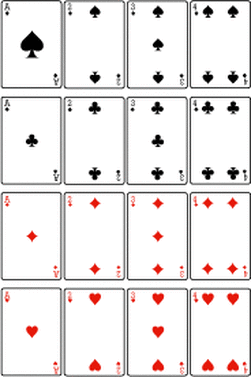The 22 Game
Place sixteen playing cards as shown.
Two players alternately turn down a card and add it to the common total. The winner is the person who makes the total 22 or who forces the other player to go beyond 22.
For example, Alice turns down a 3, Bill turns down a 4 making the total 7. Then Alice turns down a 1, making the total 8, and Bill turns down another 4, making the total 12. Alice turns down a 3 (total 15). Bill turns down a 3 (total 18) and Alice wins by turning down a 4.
Another example: Alice and Bill turn down 1 and 1, then 1 and 1, then 2 and 2, then 3 and 3, then 3 and 4. The common total is 21, and so Bill wins because there are no 1's left and what ever Alice turns down will bring the total to more than 22.
Remarks: This is a puzzle by Dudeney. This was a very popular puzzle at one math fair. Rather than playing against the visitors, the presenters encouraged visitors to play against each other. In this way, the presenters were able to help the visitors without causing the visitors to feel defeated.
Two players alternately turn down a card and add it to the common total. The winner is the person who makes the total 22 or who forces the other player to go beyond 22.
For example, Alice turns down a 3, Bill turns down a 4 making the total 7. Then Alice turns down a 1, making the total 8, and Bill turns down another 4, making the total 12. Alice turns down a 3 (total 15). Bill turns down a 3 (total 18) and Alice wins by turning down a 4.
Another example: Alice and Bill turn down 1 and 1, then 1 and 1, then 2 and 2, then 3 and 3, then 3 and 4. The common total is 21, and so Bill wins because there are no 1's left and what ever Alice turns down will bring the total to more than 22.
Remarks: This is a puzzle by Dudeney. This was a very popular puzzle at one math fair. Rather than playing against the visitors, the presenters encouraged visitors to play against each other. In this way, the presenters were able to help the visitors without causing the visitors to feel defeated.

